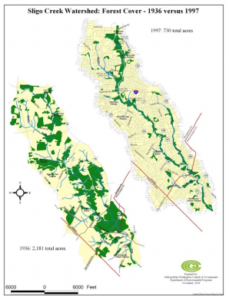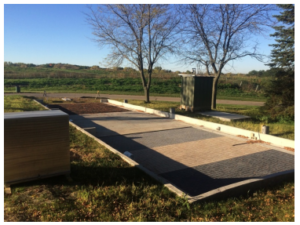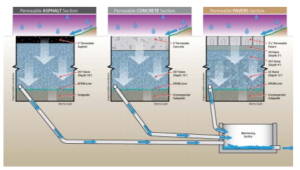Pat Ratkowski on the most damaging development in the Sligo Creek watershed in the last three hundred years.
Question: What’s the most damaging development in the Sligo Creek watershed in the last three hundred years?
Answer: Asphalt (with an assist from concrete and roofing shingles).
You may have first thought of forest clearcutting, and that’s right too; the felling of the region’s original tree cover to create farms and pasture land was a signature event for the ecosystem as a whole, including its streams and rivers. Yet while much of the Valley and surrounding County were turned into agricultural land during the 18th and 19th centuries, there were still patches of forest that were preserved in wetland and low land areas, for timber and firewood, on properties that were taken out of active farming, etc. But over the past century, even these remaining forest remnants have been disappearing as well; in 1936 about 31% of the Sligo watershed was forested, but by 1997 only about 10% of the Valley had forest cover.
What’s more, during this most recent wave of deforestation, not only were the trees removed, but what most often took their place were not crops or meadows or orchards, but asphalt, concrete and other impermeable surfaces. Today, more than 1/3 of the Sligo Creek watershed is covered by impermeable surfaces. Now you may be thinking, “Wait a minute. So just why are impermeable surfaces Bad for streams like Sligo Creek?” Well…
Impermeable surfaces do not allow rainfall to slowly soak back into the ground over hours and days, giving plant root systems and underground aquifer pore spaces time to absorb the new moisture. Instead, impermeable surfaces send massive quantities of water racing across sidewalks, roads, roofs and parking lots to the nearest downspout, storm drain or gutter. These in turn, route the water (heated by contact with roadways that can reach temperatures in excess of 140F in summer) through the storm water system directly into our tributaries, streams and rivers. There, this torrent can carry away anything trying to cling to the sides or bottom of the waterway. In fact, during the biggest storms, the force of the water can actually scour away the bottom of the stream itself, pushing tons of rock and sediment downstream while digging out the streambottom substrate that is home to the macroinvertebrates that are the foundation of an aquatic ecosystem. So, to recap: impermeable surfaces starve plants and underground aquifers of rainfall, instead forcing too much water through stream channels far too quickly, carrying any living thing in the way meters or miles downstream, all while tearing up the stream’s bed and eroding its banks. So when it comes to the Creek, these surfaces are Bad: black helmet, labored breathing, red light saber – really Bad. But there is hope, some of which goes by the name “permeable pavement,” impermeable pavement’s hole-filled, environmentally-conscious cousin. Bill Selbig, a USGS Research Hydrologist in Wisconsin is working to see if there can be a bigger role for this more stream-friendly sort of pavement in urban spaces like the Sligo watershed. He and his USGS Wisconsin Water Science Center team just finished a year-long experiment at a Middleton, Wisconsin testing area to see how three different types of permeable pavement behave under real world conditions. 
From left to right, the testing area includes permeable asphalt, permeable concrete and permeable pavers, all installed at the end of a campus parking lot. All three of these surfaces contain tiny holes or channels within them that allow liquids like rain and storm runoff to percolate down and through them to the soil below, rather than simply being routed across the top of the surface and downhill to a waiting street gutter or storm drain.
Surface runoff that moved over or through these 3 test plots was collected and analyzed for substances like phosphorus, chloride and suspended sediment.
While the research paper has not yet been formally published, preliminary results suggest there are some lessons to be learned already. It appears all three surfaces helped reduce the amount of suspended solids making their way into downstream waterways, on the order of 60% t0 80% reductions, with the pavers and permeable concrete performing best. Likely related to this performance was the fact that the pavers and permeable concrete were both effectively clogged with sediment after about 8 months, and needed to be replaced or brushed clear (pavers) or power washed out (permeable concrete). The researchers also observed a temperature drop in the water as it percolated down through the surfaces, though the extent of this effect is still being studied. It seems that the permeable surfaces slowed, cooled and cleaned the surface water runoff to some degree, but that regular maintenance would be required to sustain these effects, and that the exact magnitude of these benefits still needs to be analyzed.
Nonetheless, a vehicle- and pedestrian-ready surface that could reliably, sustainably cool, clean and slow rainfall on its way to waterways would be a big step toward restoring urban creeks and rivers toward better health. Work on permeable pavement is going on at universities and industry centers around the country, including UMDCollege Park, and while there are many challenges still ahead, progress is being made toward a softer set of hard surfaces. For more information on permeable pavement, you can follow the links below:
http://wi.water.usgs.gov/non-point/permpave/permpave_study_design.html
http://www.asphaltpavement.org/index.php?option=com_content&task=view&id=359 &Itemid=863
https://www.epa.gov/soakuptherain/permeable-pavement
http://www2.montgomerycountymd.gov/mcgportalapps/Press_Detail.aspx?Item_ID=1 7322
And if you’d like to know where the Montgomery County Council stands on permeable pavement, you can read up on it at http://www.montgomerycountymd.gov/council/ or reach your representatives at 240-777-7900.


